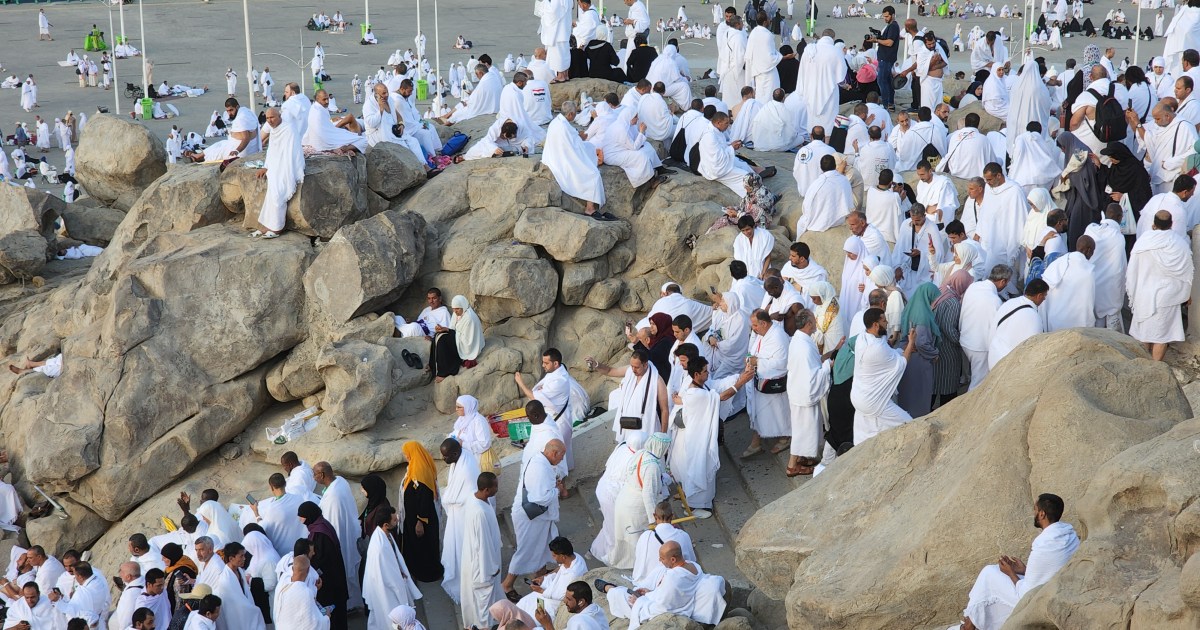The pilgrims of the Sacred House of God, since this Friday morning, began to flock to the level of Arafat to perform the greatest pillar of Hajj, after they spent yesterday the day of Al-Tarwiyah in Mina, near Mecca, following the Sunnah of the Messenger, may God bless him and grant him peace.
About one million pilgrims - including 850,000 from outside Saudi Arabia - perform the Zuhr and Asr prayers, short and combined, and they stay in the hills of Arafat until sunset, after which they flee to Muzdalifah, where they will pray Maghrib and Isha combined late and spend their night there in preparation for the work of the Day of Sacrifice.
Mount Arafat is located more than 20 kilometers to the east of Mecca, and it is a flat plain and 10 kilometers from the Shaar of Mina, where pilgrims will go to stone the Jamarat tomorrow, Saturday, on the first day of Eid al-Adha.
Arafat is the only one of the holy sites that lies outside the boundaries of the Great Mosque of Mecca.
tears and prayers
As soon as they reached Arafat, the guests of the Most Merciful sat down, some prayed, others shed tears, and some took selfies to document these important moments in their lives. Bin Abdul Karim Al-Issa.
Egyptian Hajji Farhana Amin said, "I did not dream of being here. Praise be to God, our Lord has blessed us with the pilgrimage after years in which I sought to perform the obligatory prayer."
The homelands were not absent from the prayers and wishes of the pilgrims. Tunisian Hajj Afif Al-Ghanimi said, "My feeling today is that of Fayyad... a strange feeling. I ask my Lord for stability for all countries and for our country Tunisia, and we hope that it will rise economically and socially."
#SPA_Photos | Scenes from the influx of Rahman's pilgrims to Upper Arafat.# Peacefully_Amen |
#Was_Am pic.twitter.com/20nEgEPqRS
— SPAregions (@SPAregions) July 8, 2022
This year's season is the first after the restrictions imposed by the Corona virus were lifted in the past two years, as the pandemic greatly reduced the number of pilgrims, and the pilgrimage of the past two years was limited to pilgrims from within the Kingdom.
strict measures
Rituals are performed this year amid strict security and health measures in the first Hajj season, two years after the spread of the Corona pandemic, and among the most prominent of these measures is the sterilization of the Grand Mosque 12 times a day.
The Saudi authorities allowed one million Muslims who received vaccines against the Corona virus to perform the Hajj this year, after two years of significantly reducing the numbers due to the epidemic.
And the Hajj season this year - in which the participants were chosen by lottery - is much larger than the previous two seasons in 2020 and 2021, but it is still smaller than normal times. In 2019, about 2.5 million Muslims from all over the world participated in the annual Hajj rituals, which is one of the The Five Pillars of Islam and an obligation that Muslims who are able to perform must perform it once in their lifetime.
But then, the outbreak of the Corona virus forced the Saudi authorities to significantly reduce the number of pilgrims, as 60,000 citizens and residents in the Kingdom participated and were fully vaccinated in 2021, compared to a few thousand in 2020.
This year’s pilgrimage is limited to the age group less than 65 years, with the requirement to complete immunization with basic doses of Corona vaccines approved by the Saudi Ministry of Health.
The authorities established many health facilities and mobile clinics, and equipped ambulances to meet the needs of pilgrims, especially with the high temperatures.
Ambulance teams are deployed in various locations inside the Grand Mosque, and dozens of volunteers line up in long queues while holding wheelchairs to help those who cannot walk long distances.

